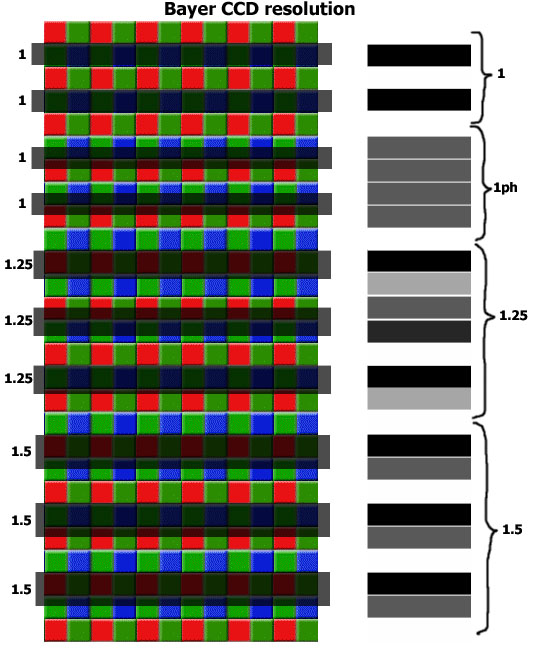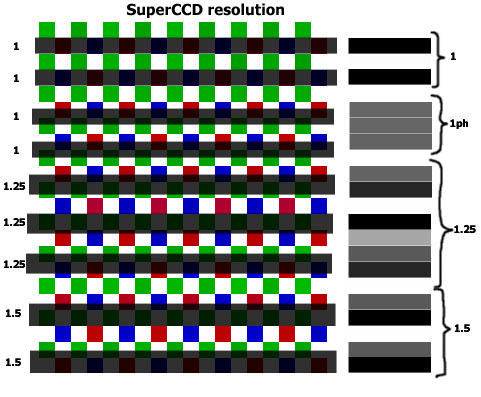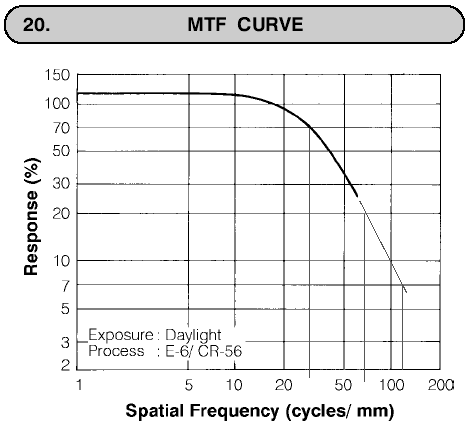Resolution of digital SLR cameras, lens matching and film resolution
Bayer CCD
|
|
Sometimes, Bayer CCD can recognize spatial frequencies 1/(2*pixel size), but for near 0 phase shift only. For phase shift (relatively CCD sensors position) nearĀ½ or ¾ pixel, contrast tend to zero value. Then, recognizing of spatial frequencies 1/(2*pixes size) is not dynamically stable.
For spatial frequencies 1/(2*1.25*pixel size) lines recognized, but with contrast loss. Dynamical stability for this spatial frequency is not so good (MTF drop at some phase shifts, aliasing appeared).
For spatial frequencies 1/(2*1.5*pixel size) and less MTF tend to 100% (with adjacent pixel low contrast). Spatial frequencies less than 1/(2*1.5*pixel size) are dynamically stable for recognizing by CCD and digital cameras firmware.
|
SuperCCD, ōdiagonalö reading of the Bayer structure (white squares mean pixel that needed to spatial interpolation)
|
|
Like Bayer CCD, SuperCCD sometimes can reach 100% MTF at 1/(2*pixel size) spatial frequency (when phase shift near to 0 value). I have some pictures where this limit is reached really. For phase shift values near ½ or ¾ pixels, MTF value is equal to zero. For spatial frequency 1/(2*1.25*pixel size) MTF value according to phase shift, fluctuate from 30% to 75%. All lines can be recognized, but MTF cannot be defined because of low dynamical stability (aliasing appear). For spatial frequency 1/(2*1.5*pixel size) all lines are recognized with MTF tend to 100% value (average value is 87.5%). |
|
|
5x scaled (by nearest neighbor algorithm) sample from S2Pro camera in 4288x2880 resolution. Spatial frequency 1/(2*p) is recognized (because little phase shift near 0 value by accident. |
Then, we able to calculating maximum (CCD based) resolutions of the popular cameras
Nikon D100, CCD size 23.4x15.6mm, 3032x2016 pixels, 7.8 um
Dynamically stable resolution: 3032/23.4/2/1.5 = 43.2 lp/mm, 1011 line pairs/long side
Dynamically unstable resolution: 3032/23.4/2/1 = 64.8 lp/mm, 1516 line pairs/long side
Canon D60, CCD size 22.7x15.1mm,Ā 3072x2048 pixels, 7.4um
Dynamically stable resolution: 3072/22.7/2/1.5 = 45.1 lp/mm, 1024 line pairs/long side
Dynamically unstable resolution: 3072/22.7/2/1 = 67.7 lp/mm, 1537 line pairs/long side
Fujifilm S2Pro, CCD size 23.0x15.5, read 4288x2880 pixels (with spatial approximation)
Dynamically stable resolution: 4288/23.0/2/1.5 = 62.0 lp/mm, 1426 line pairs/long side
Dynamically unstable resolution: 4288/23.0/2/1 = 93.2 lp/mm, 2144 line pairs/long side
Canon D1s, CCD size 35.8x23.8mm,Ā 4064x2704 pixels
Dynamically stable resolution: 4064/35.8/2/1.5 = 37.8 lp/mm, 1353 line pairs/long side
Dynamically unstable resolution: 4064/35.8/2/1 = 56.8 lp/mm, 2033 line pairs/long side
Kodak DCS 14n, CCD size 36x24mm, 4536x3024 pixels
Dynamically stable resolution: 4536/36/2/1.5 = 42.0 lp/mm, 1512 line pairs/long side
Dynamically unstable resolution: 4536/36/2/1 = 63.0 lp/mm, 2268 line pairs/long side
What is strange ¢ resolution of S2Pro never was equal (moreover, never was better) per long side than resolutions of Canon -1Ds or Kodak DCS 14n in the objective tests. There is, at least, 2 reasons:
- S2 Pro has more CCD resolution, that (as a rule) cannot reached by the most lens. If MTF of the lens at spatial frequency 93 lp/mm is about 3-5%, product of CCD MTF and lens MTF will be less than visible 2-3% contrast. Then, at testing must be used superior lens for comparable results. Second conclusion is that for S2Pro we must use excellent lens if we want to get Super CCD resolution advantage (50-60 lp/mm for 11-14Mp cameras can be derived from more cheap lens than lens that produce 90lp/mm with visible contrast).
- S2Pro produce more noisy images at high spatial frequencies because of spatial interpolation.
Some comments about the film technology.
Fujifilm developers estimated resolution of Velvia film (G=9) about 30 millions of effective elements (in 3 layers, that mean 10 Mpixels image) and about 50 millions for Provia 100F.
I calculated another way by the same results:
(1) Granularity = 100/M,
where M = minimum magnification scale, when granularity become visible.
(2) Human eye dot resolution is 0.1mm = 100microns
Then, for known Granularity factor (G), size of the grain (S) will be
S = G/10^6
Fuji Provia 100 (old) with G=10 have visible grain size about 10microns = effective pixel size
Resolution = 36mm/10um x 24mm/10um x 3 layers = 3600x2400x3 = 26 Mp (or color 9Mp)
Fuji Velvia 50 with G=9 have visible grain size about 9 microns
Resolution = 36mm/9um x 24mm/9um x 3 layers = 4000x2467x3 = 32 Mp (or color 10.6Mp)
Fuji Provia 100F with G=8 have visible grain size about 8 microns
Resolution = 36mm/8um x 24mm/8um x 3 layers = 4500x3000x3 = 40.5 Mp (or color 13.5Mp)
I donÆt know, why Fuji developers estimated 50 millions of elements ¢ may be, they calculated this value for 4 layers film?
This estimating made for visible grain size, we can recognize some details that made by little b/w grains with sizes less than 1 microns (but in this case S/N ratio will be very small, about 1).
Film resolution (135 lp/mm for Provia 100F etc.) calculated for MTF about 7% and for alone black&white grains (with S/N=1) is not dynamically stable. I think that for film/sensor compare we should using low-contrast (grayscale) resolution value that is 63 lp/mm for Provia 100F.
Another way is using 20% MTF threshold, which reached at the same 63 lp/mm like dynamical stability threshold. (from spatial frequency 20-30 lp/mm, contrast cannot derived from biggest grains (its are exposed by less spatial frequencies) and derived from less grains (in the background of big grain) that lead to contrast drop.
|
|
MTF of the Fujifilm Provia 100F (derived from official pdf document, extrapolated for spatial frequencies 60-135 lp/mm). |
Moreover, I think, I can explicate, why scanning with 8000dpi instead of 4000 dpi can produce only a bit of additional details.
4000 dpi scanning can resolve dynamically stable 4000/25.4/3lpmm = 52.5 lp/mm or dynamically unstable 4000/25.4/2lpmm = 78 lp/mm
8000 dpi scanning can resolve dynamically stable 8000/25.4/3lpmm = 103 lp/mm or dynamically unstable 8000/25.4/2lpmm = 156 lp/mm
Because of better of non-special films can reached (at 1000:1 test target and S/N=1) dynamically unstable 135-145 lp/mm (with 5-7% MTF, best lens can resolve about 100 lp/mm (with 3-5% MTF), then united lens-film resolution with MTF>3-5% will be about 60 lp/mm (that required 60*3 lpmm*25.4 = 4572 dpi scanner resolution for non-aliased scanning).
This resolution mostly can be recognized by 4000dpi scanners. 8000 dpi scanner with the same lens like 4000dpi scanner can add about 60-52.5/52.5 = 14% extra information about object and as a rule, 8000 dpi scanners have more complicated lens with better MTF, that lead to 20-25% extra recognized details of image (not about of film grain, which will recognized more better).
Using of 8000 dpi scanner is needed for high-resolution microcopies/microfiches films with more than excellent (in terms of resolution) special high-contrast lens for microcopies production.
TeddyBearĀĀĀĀĀĀĀĀĀĀĀĀĀĀĀĀĀĀĀĀĀĀĀĀĀĀĀĀĀĀĀĀĀĀĀĀĀĀĀĀĀ http://digicam.narod.ru
20/10/2002



